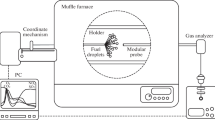The results of experimental research on ignition and liquid biofuel drops combustion characteristics are presented. The main fuel components used are rapeseed oil, water, and sawdust. The key recorded process characteristics are minimum ignition temperature, gas phase and heterogeneous combustion delay time, and duration of combustion. The conditions for efficient and safe initiation of combustion of promising liquid biofuels are determined. The advantages of biofuel use over suspension fuels based on conventional energy resources and wastes of their processing and enrichment are ascertained.





Similar content being viewed by others
References
H. K. Nguyen, J. H. Moon, S. H. Jo, et al., “Ash characteristics of oxy-biomass combustion in a circulating fluidized bed with kaolin addition,” Energy, 230, 120871 (2021).
L. A. Raman, B. Deepanraj, S. Rajakumar, and V. Sivasubramanian, “Experimental investigation on performance, combustion and emission analysis of a direct injection diesel engine fuelled with rapeseed oil biodiesel,” Fuel, 246, 69–74 (2019).
M. Zhai, X. Li, D. Yang, Z. Ma, and P. Dong, “Ash fusion characteristics of biomass pellets during combustion,” Journal of Cleaner Production, 336, 130361 (2022).
R. Ma, W. Fan, X. Wang, et al., “Conversion of volatile nitrogen and char nitrogen to NO in oxy-biomass combustion,” Journal of the Energy Institute, 100, 120–128 (2022).
E. David and J. Kopac, “Pyrolysis of rapeseed oil cake in a fixed bed reactor to produce bio-oil,” Journal of Analytical and Applied Pyrolysis, 134, 495-502 (2018).
D. Mei, D. Guo, C. Wang, et al., “Evaluation of esterified pyrolysis bio-oil as a diesel alternative,” Journal of the Energy Institute, 93, No. 4, 1382–1389 (2020).
A. Elfasakhany, “Investigation of biomass powder as a direct solid biofuel in combustion engines: Modelling assessment and comparisons,” Ain Shams Engineering Journal, 12, No. 3, 2991–2998 (2021).
V. Józsa and A. Kun-Balog, “Stability and emission analysis of crude rapeseed oil combustion,” Fuel Processing Technology, 156, 204–210 (2017).
I. Horvat, D. Dović, and P. Filipović, “Numerical and experimental methods in development of the novel biomass combustion system concept for wood and agro pellets,” Energy, 231, 120929 (2021).
K. Vershinina, P. Strizhak, V. Dorokhov, and D. Romanov, “Combustion and emission behavior of different waste fuel blends in a laboratory furnace,” Fuel, 285, 119098 (2021).
G. V. Kuznetsov, K. Y. Vershinina, T. R. Valiullin, and P. A. Strizhak, “Differences in ignition and combustion characteristics of waste-derived oil-water emulsions and coal-water slurries containing petrochemicals,” Fuel Processing Technology, 179, 407–421 (2018).
V. V. Dorokhov, G. V. Kuznetsov, K. Y. Vershinina, and P. A. Strizhak, “Relative energy efficiency indicators calculated for highmoisture waste-based fuel blends using multiple-criteria decision-making,” Energy, 234, 121257 (2021).
J. S. J. Alonso, J. A. L. Sastre, C. Romero-Ávila, and E. J. L. Romero, “Combustion of rapeseed oil and diesel oil mixtures for use in the production of heat energy,” Fuel Processing Technology, 87, No. 2, 97–102 (2006).
Author information
Authors and Affiliations
Corresponding author
Additional information
Translated from Khimicheskoe i Neftegazovoe Mashinostroenie, Vol. 58, No. 3, pp. 38−43, March, 2022.
Rights and permissions
Springer Nature or its licensor holds exclusive rights to this article under a publishing agreement with the author(s) or other rightsholder(s); author self-archiving of the accepted manuscript version of this article is solely governed by the terms of such publishing agreement and applicable law.
About this article
Cite this article
Antonov, D.V., Dorokhov, V.V., Nyashina, G.S. et al. Limiting Ignition Conditions and Time Characteritics of Combustion of Liquid Biofuel Drops. Chem Petrol Eng 58, 239–247 (2022). https://doi.org/10.1007/s10556-022-01081-5
Published:
Issue Date:
DOI: https://doi.org/10.1007/s10556-022-01081-5



